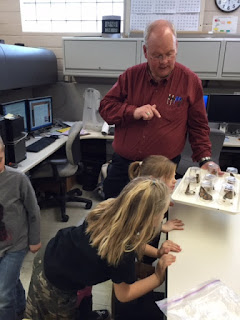1st graders visit insect lab at ISU
Five first grade students from Guthrie Center elementary school visited the ISU entomology department's monarch lab. Keith Bidne, the insectary manager in the Entomology Department, had the students' attention as he showed them some monarchs which had just emerged from their chrysalis. If you look closely, you can see that the monarchs emerged from a chrysalis that had formed on a 6 oz. cup! The monarchs will be processed and moved to a larger home once their wings have dried.
Five first grade students from Guthrie Center elementary school visited the ISU entomology department's monarch lab. Keith Bidne, the insectary manager in the Entomology Department, had the students' attention as he showed them some monarchs which had just emerged from their chrysalis. If you look closely, you can see that the monarchs emerged from a chrysalis that had formed on a 6 oz. cup! The monarchs will be processed and moved to a larger home once their wings have dried.
Below Mr. Bidne sterilizes his equipment so he can test each recently emerged adult monarch for the disease OE.
Below: After sterilizing his equipment, Mr. Bidne takes a piece of tape and presses it against the monarch's abdomen. He will look at each piece of tape under the microscope to see if any of the football shaped OE parasites are present.
The 1st graders also helped Mr. Bidne transplant some tropical milkweed in the greenhouse. He even gave us some to take home!
(photo courtesy of Kris Langgaard)
1st graders to raise monarchs in May
At the beginning of May, Mr. Bidne will supply each of these 1st grade students with a monarch larva to care for. Every day they will be responsible for cleaning the frass from their "cage," putting a new milkweed leaf in the cup, and writing about their observations. When the butterflies emerge from their chrysalis at the end of the school year, we will release our monarchs in our school's rain garden, where our Conservation Corps (our elementary students involved in after school conservation work) have planted the monarch's favorite milkweed and flowering plants.
1st graders in leadership role next fall
Next fall, as second grade students at Guthrie Center Elementary School, these students will be in leadership roles assisting other class members in raising their own monarchs. This will be the second year in a row that our students will do that, thanks to the generosity of the ISU monarch lab.
A great website for elementary students to learn about monarchs:
https://www.learner.org/jnorth/monarch/
Before our field trip to ISU, 1st graders used this website to learn about monarchs.
To follow the ISU monarch consortium's activities and to learn about their latest research, go to: http://monarch.ent.iastate.edu/














